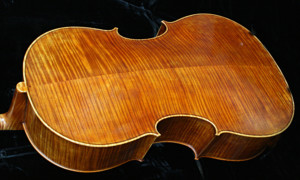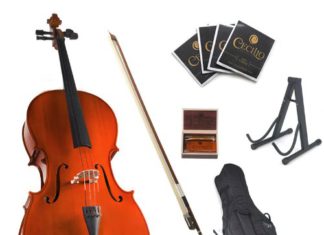When it comes to buying a cello, it is never a one-size-fits-all matter. Unlike the violin and viola, the cello is much larger so the individual’s size must be taken into account. Even among cellos of the same size, there might be differences in their sound due to their different details like strings, wood materials and so on. Amateur and professional cellists have all encountered problems when getting the perfect fit – size, acoustics, projection and comfort. So how do you go about buying a cello? What should you consider when buying a cello? What cello brand is right for you?
Should I Even Buy a Cello?
The first question you need to ask when looking to buy a cello is whether buying is even the right option for you. In our “Should I Rent or Buy a Cello?” guide, we offer an overview of the costs associated with renting and buying cellos to give you an overview of the options.
The other question you should ask yourself is whether the cello is even the right instrument for you. This is a critical question since the cello is an expensive purchase.
Once you have answers to both of these questions, you can continue reading below.
Different Levels
Cellos come in different levels for players on different stages of their learning journey. Many students start out by renting cellos for practice until they are ready to own one. Essentially, cellos fall under three categories:
- Student Cellos: These are for beginners. Young students or players at the early stage of learning the cello are constantly working on the basics of playing, tone production, fingering, bowing etc. Hence, maple (dyed black to resemble ebony) is sometimes used for the pegs and fingerboards, areas that are exposed to more friction. Student cellos are mostly machine-made to keep costs low while maintaining tone consistency. Quite affordable. Prices range from $200 – $2,500.
- Intermediate to Advanced Cellos: With higher workmanship, the sound of an intermediate cello is also much better. There are more dynamics and stronger projection. The pegs and fingerboards are crafted with ebony and most of the instrument is handcrafted. Prices range from $500 – $10,000.
- Professional Cellos: Pure craftsmanship using the finest quality of wood, professional cellos exude a rich tone and wide dynamics. Masterpieces like these are expensive. Prices go from $10,000 onwards.
Typically, how much one pays for a cello is how much one can expect from the quality. A cello priced at the extreme low hundreds tends to be “unplayable” while the more expensive ones can balance both playability and sound production better. Of course, the price is not always merely an indication of product quality. Sometimes, it also incorporates the name of the cello maker. As a cello maker’s fame increases, so does the value of the instruments he crafts.
For a detailed analysis on different cello brands, check out our best cello brands guide.
How to Choose the Right Cello
Ask Your Teacher
The first piece of advice given by experts, cello makers and professional cellists would be for the student to consult his or her teacher. Music teachers understand what their students need more than anyone would. They can make better recommendations given their experience and close bond with the students.
Test Cellos
The second piece of advice would be to go to a violin shop and test out their cellos. Cellos are less well-known than violins. Naturally, there will not be a variety of cellos as comprehensive as the violins to choose from. Give our best cellos brands guide a review before you go to test cellos so that you know which cello brands to look for. The selection may be scarce at general music shops but that selection will open up a lot more at a good violin shop. Try not to purchase a cello over the Internet without testing it first. Trying out an instrument in person is crucial. Only then can the student feel if the size is comfortable, the projection far enough, or if the resonance is right.
Here are other factors for consideration:
- The size affects the sound. Cellos come in a variety of sizes ranging from 1/16 up to 4/4 (full-size). While most students early on will play on instruments somewhere between 1/8-1/2, most adults play 3/4 or 4/4 depending on their size. The bigger the cello, the more tone is produced by the instrument, making the cellist sound more mature.
- The height of the ribs, the size of the upper bout, neck size, string or scale length all contribute to how big the instrument feels and how well it plays. Comfort matters more than size in the sense that if a cellist struggles during the playing experience, she simply won’t play well.
- Responsiveness, resonance, tone, projection. The cello’s sound is mellow and darker in nature. In an orchestra, the cellist needs to make sure that she can be heard above the other instruments, hence projection in particular is very important. All of these sound elements will affect a player’s performance, which is why choosing a cello in person rather than over the Internet, or investing in a higher quality cello, is necessary.
- Getting a powerful C string is sweet, but do not neglect the other strings. Ensure there is coherence in sound quality in all four strings. Also, it seems that shorter strings are more comfortable to play on, but longer strings may give a slightly stronger power. It all depends on what it is the player prizes.
- The quality and weight of the bow can affect a performance. Be sure to test several of them out before buying.
To evaluate the cellos, test them with different bows, play scales, play different passages (both fast and slow ones), play all strings in all registers, and play with and without vibrato. Check the tone of different cellos. Which sounds most appealing? Is it easy to move on the fingerboard? If possible, ask someone else (perhaps another cellist or teacher in the shop) to play the cello while you stand across the room to listen. Does the sound project well?
Quality of the Material
The quality of the cello material impacts both the sound and the viola price. Cheaper woods from America and China usually have a brighter sound compared with the warmer and sweeter tones of the more-expensive European woods. The “flame,” or as some say “tiger stripe,” on the back, sides and scroll of the cello affects the cello price than the top spruce grain. A high “flame” content is highly desired for its beauty and is generally indicative of a higher cello price and better the sound as compared to a cello with little or no “flame,” mostly found on student instrument’s. A well-made cello will be able to hide the center crease on the back with the flame. This is one way of quickly identifying quality workmanship.

Where to Buy a Cello
It is not necessary to buy extremely expensive cellos. There are plenty of high quality instruments in the mid-price range that could also be satisfying. The main thing to remember is to purchase from a reputable retailer that has a refund policy and which allows you to try out their instruments. Consult a teacher for recommendations if possible. Other retailers are second-hand retailers, luthiers and, if the Internet is your only choice, Amazon and eBay.
Should You Rent or Buy a Cello?
If you are shopping for a student cello, you will often be tempted to rent an instrument so that there is no long-term commitment and you don’t have to worry about reselling if the student doesn’t continue playing past the contract period. However, there are several good reasons why buying a cello instead of renting is a good idea:
- Rental fees often add up quickly. Let’s say you have a 12-month rental contract where you pay $30/month. In the end you’ll end up paying $360, when you could’ve bought a new or gently used cello for ~$200. While many music shops will give you rental credit during the contract that could be used to buy a cello at the end of the contract, you’d probably be better off buying the cello outright.
- Music shops will often all you trade up cellos you have bought from them or other shops. If you need a bigger or better cello, most music shops will defray the new cello price with the resale value of the cello you bought originally.
- A well-chosen beginner’s instrument that is well cared for will retain its value and usually return a substantial part of its purchase price when sold used or traded in for a better quality instrument.
- Higher-quality cellos may appreciate in value over time; their voices “open up” as they age.
- Rental instruments may be a bit worse for wear with nicks, scratches, tape marks on the fingerboard, and come with used strings and an already rosined bow. You’re also liable for any damage on a rented violin.
What Else Do I Need?
For a complete list of cello accessories you will need to buy in addition to the cello, see our Buying a Cello Checklist guide.
- Case: To store your cello, you need a solid case since the instrument is very fragile. If the cello is for a student, a sturdy case is even more of a necessity. Most beginner cello outfits come with a soft case, but just in case (no pun intended), there are some great hard cello cases on Amazon.
- Rosin: Rosin is applied to your bow and used to create friction between your bow and cello. Without rosin, your cello would not make any sound.
- Bow: Picking the right cello bow to use with your cello is key. You need to make sure it sounds good, but at a reasonable price. See our guide to buying a cello bow.
- Rock Stop: The rock stop is optional, but allows you to keep the cello from slipping.
- Extra Strings: While not as likely to break or fray as violin strings, cello strings do occasionally break. Keeping an extra pair in your case is highly recommended. You can check out our review of the best cello strings to see which ones are best for you.
Protecting Your Investment
Once you’ve decided on a cello to buy you’ll want to make sure it is protected from loss, damage, and theft. Replacing such an expensive instrument can cost you a lot of money. In order to protect your investment, you should get musical instrument insurance. You can read our guide on buying musical instrument insurance for your cello to learn more.
Conclusion
The bottom line when buying a cello is to make sure you like it. If it doesn’t sound right, don’t buy it. If it doesn’t feel comfortable, don’t buy. You’re going to be spending hundreds and thousands of hours in an orchestra and the cello needs to fit you. To borrow a line from Harry Potter, the cello chooses the player.







